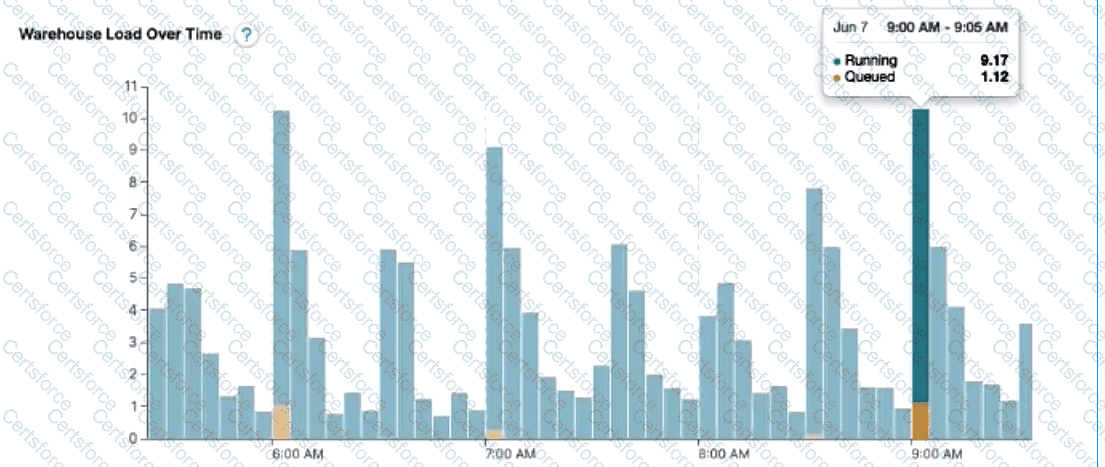A company is trying to Ingest 10 TB of CSV data into a Snowflake table using Snowpipe as part of Its migration from a legacy database platform. The records need to be ingested in the MOST performant and cost-effective way.
How can these requirements be met?
The following chart represents the performance of a virtual warehouse over time:

A Data Engineer notices that the warehouse is queueing queries. The warehouse is sizeX-Small, theminimum and maximum cluster counts are set to 1, thescaling policy is set to standard, andauto-suspend is set to 10 minutes.
How can the performance be improved?
The following DDL command was used to create a task based on a stream:

Assuming MY_WH is set to auto_suspend – 60 and used exclusively for this task, which statement is true?
A company is using a Snowflake account in Azure. The account has SAML SSO set up using ADFS as a SCIM identity provider. To validate Private Link connectivity, an Architect performed the following steps:
* Confirmed Private Link URLs are working by logging in with a username/password account
* Verified DNS resolution by running nslookups against Private Link URLs
* Validated connectivity using SnowCD
* Disabled public access using a network policy set to use the company’s IP address range
However, the following error message is received when using SSO to log into the company account:
IP XX.XXX.XX.XX is not allowed to access snowflake. Contact your local security administrator.
What steps should the Architect take to resolve this error and ensure that the account is accessed using only Private Link? (Choose two.)
An Architect with the ORGADMIN role wants to change a Snowflake account from an Enterprise edition to a Business Critical edition.
How should this be accomplished?
In a managed access schema, what are characteristics of the roles that can manage object privileges? (Select TWO).
A company is designing a process for importing a large amount of loT JSON data from cloud storage into Snowflake. New sets of loT data get generated and uploaded approximately every 5 minutes.
Once the loT data is in Snowflake, the company needs up-to-date information from an external vendor to join to the data. This data is then presented to users through a dashboard that shows different levels of aggregation. The external vendor is a Snowflake customer.
What solution will MINIMIZE complexity and MAXIMIZE performance?
A new table and streams are created with the following commands:
CREATE OR REPLACE TABLE LETTERS (ID INT, LETTER STRING) ;
CREATE OR REPLACE STREAM STREAM_1 ON TABLE LETTERS;
CREATE OR REPLACE STREAM STREAM_2 ON TABLE LETTERS APPEND_ONLY = TRUE;
The following operations are processed on the newly created table:
INSERT INTO LETTERS VALUES (1, 'A');
INSERT INTO LETTERS VALUES (2, 'B');
INSERT INTO LETTERS VALUES (3, 'C');
TRUNCATE TABLE LETTERS;
INSERT INTO LETTERS VALUES (4, 'D');
INSERT INTO LETTERS VALUES (5, 'E');
INSERT INTO LETTERS VALUES (6, 'F');
DELETE FROM LETTERS WHERE ID = 6;
What would be the output of the following SQL commands, in order?
SELECT COUNT (*) FROM STREAM_1;
SELECT COUNT (*) FROM STREAM_2;
An Architect uses COPY INTO with the ON_ERROR=SKIP_FILE option to bulk load CSV files into a table called TABLEA, using its table stage. One file named file5.csv fails to load. The Architect fixes the file and re-loads it to the stage with the exact same file name it had previously.
Which commands should the Architect use to load only file5.csv file from the stage? (Choose two.)
An Architect entered the following commands in sequence:

USER1 cannot find the table.
Which of the following commands does the Architect need to run for USER1 to find the tables using the Principle of Least Privilege? (Choose two.)